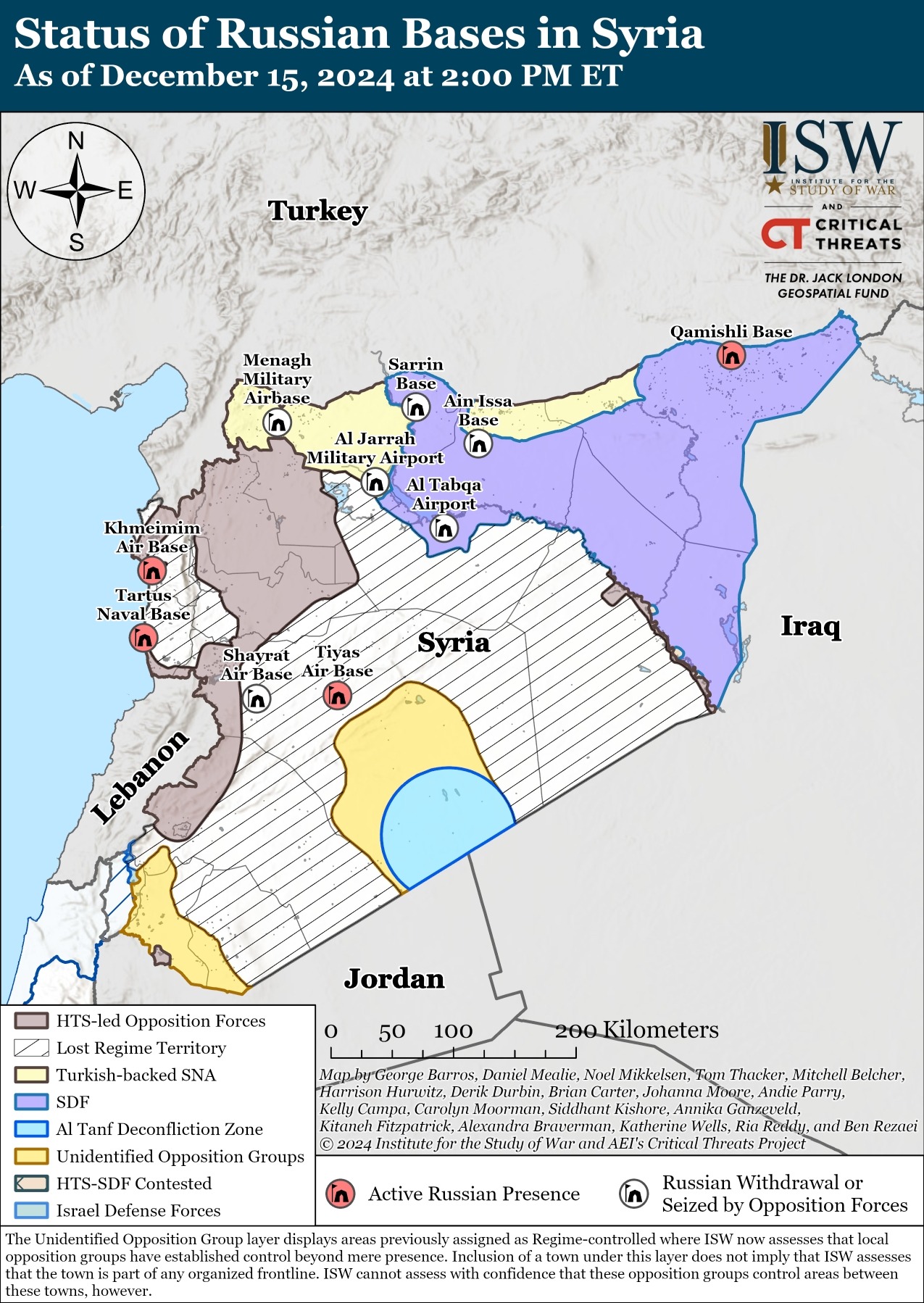 With the advent of the Trump administration, Ukraine has lost its primary war sponsor. This makes especially relevant Lutz Unterseher’s “Ukraine: Options for a Confidence-Building Defense” which outlines a “self-sustaining, emphatically defensive military” posture “without integration into a military alliance and suitable as a possible building block of an all-European security system.”
With the advent of the Trump administration, Ukraine has lost its primary war sponsor. This makes especially relevant Lutz Unterseher’s “Ukraine: Options for a Confidence-Building Defense” which outlines a “self-sustaining, emphatically defensive military” posture “without integration into a military alliance and suitable as a possible building block of an all-European security system.”
tweet
Lift the Syria Sanctions: The Principal Danger in Syria Now is Instability
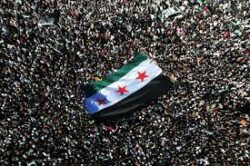 At present, the most critical international security concern regarding Syria is its stabilization – and that requires immediate and substantial aid and sanction relief. It also hinges on the new government’s capacity to restore sovereignty. Should the new government reverse course and pose a threat to global peace, the international community can adjust policy accordingly. But first things first. Full article: Lift the Syria Sanctions: The Principal Danger in Syria Today is Instability
At present, the most critical international security concern regarding Syria is its stabilization – and that requires immediate and substantial aid and sanction relief. It also hinges on the new government’s capacity to restore sovereignty. Should the new government reverse course and pose a threat to global peace, the international community can adjust policy accordingly. But first things first. Full article: Lift the Syria Sanctions: The Principal Danger in Syria Today is Instability
oped: “Hold Ukraine accountable for corruption, misspent aid”
 Author James Durso offers a rather harsh assessment of Zelensky’s war leadership: The former head of UA military, Gen Zaluzhnyi, argued that in 2023 that the war would stalemate and attention should turn to negotiations. “But Zelensky had no interest in diplomacy, because ending the war would mean ending the state of emergency, new elections and a change in the structure of international assistance. In his own political interest, he ousted Zaluzhnyi and continued a war he was warned would waste lives and money without result.” From The Hill, article links HERE.
Author James Durso offers a rather harsh assessment of Zelensky’s war leadership: The former head of UA military, Gen Zaluzhnyi, argued that in 2023 that the war would stalemate and attention should turn to negotiations. “But Zelensky had no interest in diplomacy, because ending the war would mean ending the state of emergency, new elections and a change in the structure of international assistance. In his own political interest, he ousted Zaluzhnyi and continued a war he was warned would waste lives and money without result.” From The Hill, article links HERE.
The Most Effective Antidote to ISIS Attacks? No.
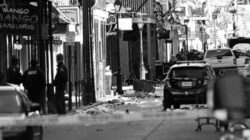
The secret US soldiers who trained free-falling with a NUKE between their legs
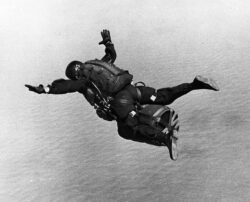 “The SADM (Special Atomic Demolition Munition) was a top secret nuclear weapon no different from the one dropped on Hiroshima, but with one crucial difference: it was small enough to fit inside a rucksack.” In 1983, a squad of Green Berets thought they were headed to Cuba to parachute in with mini-nukes. Not so. Just a practice run. ??? Daily Mail, The secret US soldiers who trained for WWIII by free-falling with a NUKE between their legs.
“The SADM (Special Atomic Demolition Munition) was a top secret nuclear weapon no different from the one dropped on Hiroshima, but with one crucial difference: it was small enough to fit inside a rucksack.” In 1983, a squad of Green Berets thought they were headed to Cuba to parachute in with mini-nukes. Not so. Just a practice run. ??? Daily Mail, The secret US soldiers who trained for WWIII by free-falling with a NUKE between their legs.
Enabling genocide? Former Biden officials reflect on the US president’s legacy
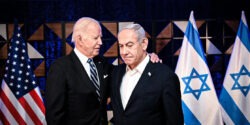 “The war in Gaza has provoked widespread humanitarian concerns, ranging from famine to ethnic cleansing. A United Nations special committee even warned Israel’s tactics in the Palestinian enclave were “consistent with genocide… But since the war was launched in October 2023, the US has been unwavering in its support for Israel’s campaign. The Biden administration provided at least $17.9bn in military aid to Israel in the first year of the war — a record sum for the Middle East country.” Al Jazeera, Enabling Genocide
“The war in Gaza has provoked widespread humanitarian concerns, ranging from famine to ethnic cleansing. A United Nations special committee even warned Israel’s tactics in the Palestinian enclave were “consistent with genocide… But since the war was launched in October 2023, the US has been unwavering in its support for Israel’s campaign. The Biden administration provided at least $17.9bn in military aid to Israel in the first year of the war — a record sum for the Middle East country.” Al Jazeera, Enabling Genocide
World Health Org Chief OK But Others Killed in Israeli Strike on Yemen Airport
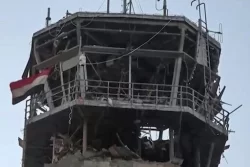 “At least four people were killed and 21 others injured in the attack on [Dec 26] after Israel struck the international airport in Sana and the city of al Hodeida.” Common Dreams, WHO Chief OK But Others Killed in Israeli Strike
“At least four people were killed and 21 others injured in the attack on [Dec 26] after Israel struck the international airport in Sana and the city of al Hodeida.” Common Dreams, WHO Chief OK But Others Killed in Israeli Strike
Red Cross: “Obliteration of health care system in northern Gaza puts civilians at grave risk”
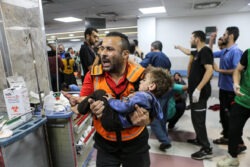 “The International Committee of the Red Cross (ICRC) reiterates its urgent call for the respect and protection of medical facilities in line with international humanitarian law. This protection is a legal obligation and a moral imperative to preserve human life.” International Committee of the Red Cross report HERE
“The International Committee of the Red Cross (ICRC) reiterates its urgent call for the respect and protection of medical facilities in line with international humanitarian law. This protection is a legal obligation and a moral imperative to preserve human life.” International Committee of the Red Cross report HERE
“Syria is doomed to instability Outside agents will stoke chaos” True?
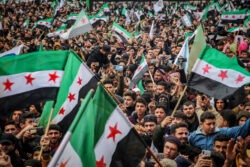 Rajan Menon: Syria is doomed to instability Outside agents will stoke chaos, Menon tours the multiple strains of instability likely to manifest in post-Assad Syria especially targeting “meddling foreigners.” Well, with Russia and Iran presently on the run, the USA, Turkey, and Israel are the meddlers of note, all having boots on the ground. Menon also notes that “the West…won’t provide sweeping sanctions relief anytime soon: it will first test HTS’s governance practices.” Probably true but certainly a mistake. The paramount threat at present is instability. So humanitarian, stability, and reconstruction aid should commence immediately. The Assad sanctions should depart as he did. Don’t grandfather in the new government. If necessary, new sanctions can be designed and imposed in the case of threats to international peace (including gross human rights violations). Otherwise, avoid efforts at coercive regime shaping – they’ve proved worse than ineffective.
Rajan Menon: Syria is doomed to instability Outside agents will stoke chaos, Menon tours the multiple strains of instability likely to manifest in post-Assad Syria especially targeting “meddling foreigners.” Well, with Russia and Iran presently on the run, the USA, Turkey, and Israel are the meddlers of note, all having boots on the ground. Menon also notes that “the West…won’t provide sweeping sanctions relief anytime soon: it will first test HTS’s governance practices.” Probably true but certainly a mistake. The paramount threat at present is instability. So humanitarian, stability, and reconstruction aid should commence immediately. The Assad sanctions should depart as he did. Don’t grandfather in the new government. If necessary, new sanctions can be designed and imposed in the case of threats to international peace (including gross human rights violations). Otherwise, avoid efforts at coercive regime shaping – they’ve proved worse than ineffective.
US says it has 2,000 troops in Syria, not 900 as previously declared
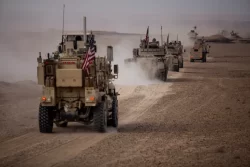 from Al Jazeera: Pentagon says the additional forces have been in Syria for ‘a while’, before fall of President Bashar al-Assad, though they were not publicly disclosed. How long? Months “at a minimum”. Why? Probably three reasons: 1. Deter Turkish attacks on US-allied Kurds. 2. Ensure the containment of 10,000 ISIS fighters (and ~30,000 kin and suspects). 3. Deter the possible advance of HTS on the US and Kurdish held Syrian oil fields. Leverage.
from Al Jazeera: Pentagon says the additional forces have been in Syria for ‘a while’, before fall of President Bashar al-Assad, though they were not publicly disclosed. How long? Months “at a minimum”. Why? Probably three reasons: 1. Deter Turkish attacks on US-allied Kurds. 2. Ensure the containment of 10,000 ISIS fighters (and ~30,000 kin and suspects). 3. Deter the possible advance of HTS on the US and Kurdish held Syrian oil fields. Leverage.
Groups Dominating post-Assad Syria, late Dec 2024
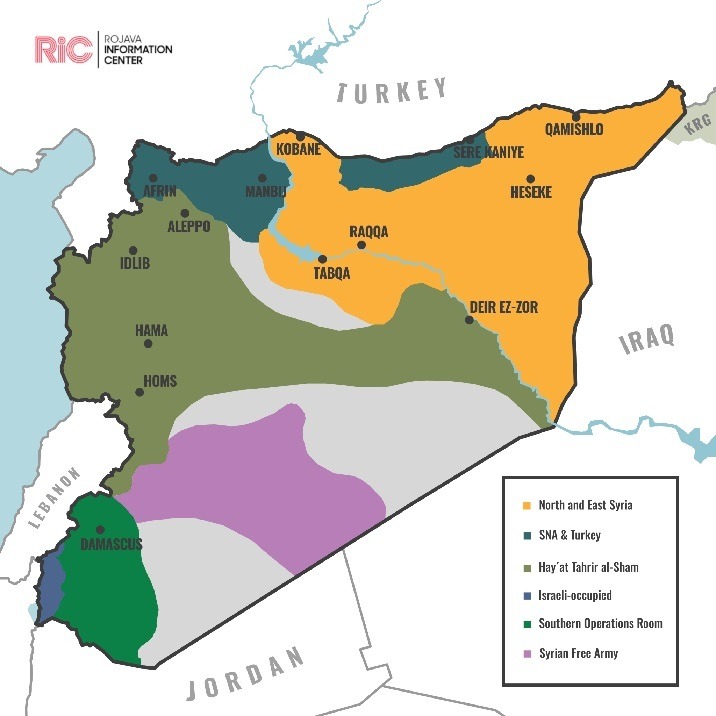
Orange Zone is controlled by the US-supported Syrian Democratic Forces (SDF) led by the Kurdish People’s Protection Units (YPG) which is the armed wing of the Syrian-based Democratic Union Party (PYD). (The PYD links with the Turkey-based Kurdistan Workers’ Party which leads a Kurdish insurgency in Turkey, earning both it and the Syrian groups the deadly ire of Ankara.)
– VOA, Future uncertain for Syria’s Kurds amid potential Turkish offensive
– Atlantic Council, Can northeast Syria delink from the PKK?
Teal Zone: Turkish Armed Forces and Turkey-supported rebel alliance, the Syrian National Army
Olive Green Zone: Hayʼat Tahrir ash-Sham (Organization for the Liberation of the Levant), chief rebel coalition. A prominent component was formerly called Jabhat Fatah al-Sham, which earlier was Jabhat al-Nusra – an official local branch of al-Qaeda.
Dark Green Zone: The Southern Operations Room is a coalition of rebel groups that took up arms beginning in 2011 but joined the Russian-sponsored “reconciliation process” in 2018 (which allowed them to retain light arms while central government agencies returned to southern towns). More recently, they joined with the efforts of HTS to depose Assad.
– Long War Journal, Analysis: Who liberated Damascus? Unpacking the Southern Operations Room’s emergence
Purple Zone: The “Syrian Free Army” (aka the Revolutionary Commando Army and/or the New Syrian Army) is a rebel alliance with a US-sponsored group at its core which is associated with the US-operated al-Tanf military base in Syria’s eastern Homs Governorate
– Daily Mail, America helped prepare Syria’s rebels weeks before they launched coup that toppled Assad
– Syrian Observer, Maghawir al-Thawra (“Revolutionary Commandos”) Changes Name. What is the Story?
ACLED: Syria – Which groups have been fighting each other and where?
Report from Armed Conflict Location & Event Data (ACLED): “Despite the recent coordination between opposition groups in the Military Operations Command (MOC) coalition led by Hayat Tahrir al-Sham (HTS), the future shape of Syria remains uncertain due to historical hostilities and ongoing divisions among the different armed groups throughout the country. ACLED data highlights previous confrontations between these groups since April 2020.”
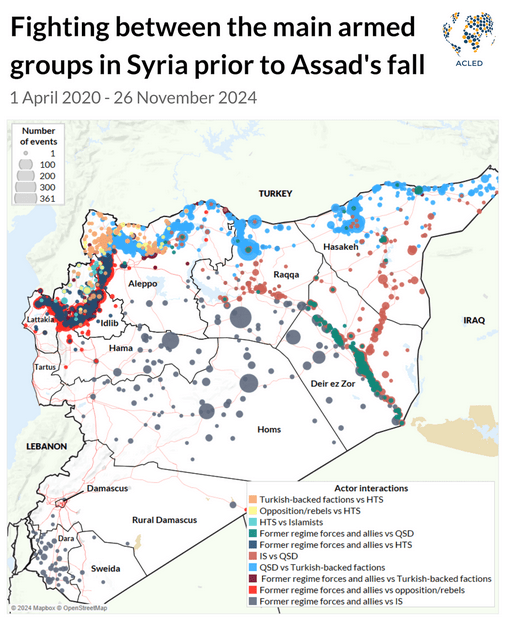
Offensive Disarmament – A Remarkable Israeli Blitz Weakens New Syrian Government
In 480 air strikes (as of Dec 12), Israel has decimated much of what remained of Syrian military assets and infrastructure. The result will be ongoing internal struggle and instability as the new Syrian Salvation Government gets no big boost in the balance of internal military power. Who will gain? Turkey and the Turkey-aligned Syrian National Army, US-aligned groups including the Kurdish-led Syrian Democratic Forces and Maghawir al-Thawra (which operates near the Jordanian border), and possibly ISIS. From Al Jazeera:

Syrian rebels had help from Ukraine
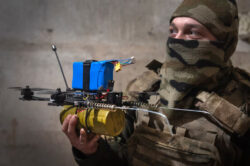 David Ignatius reports in a Washington Post op-ed that “according to sources familiar with Ukrainian military activities abroad, Kyiv provided support to the Islamist militia, Hayat Tahrir al-Sham (HTS), in it successful effort to topple Syrian President Bashar al-Assad. Specifically, it dispatched “about 20 experienced drone operators and about 150 first-person-view drones to the rebel headquarters in Idlib.” Although modest, Ukrainian support to the rebellion has been ongoing: Kyiv Post, Ukrainian Special Forces and Syrian Rebels Decimate Russian Mercenaries in Syria.
David Ignatius reports in a Washington Post op-ed that “according to sources familiar with Ukrainian military activities abroad, Kyiv provided support to the Islamist militia, Hayat Tahrir al-Sham (HTS), in it successful effort to topple Syrian President Bashar al-Assad. Specifically, it dispatched “about 20 experienced drone operators and about 150 first-person-view drones to the rebel headquarters in Idlib.” Although modest, Ukrainian support to the rebellion has been ongoing: Kyiv Post, Ukrainian Special Forces and Syrian Rebels Decimate Russian Mercenaries in Syria.
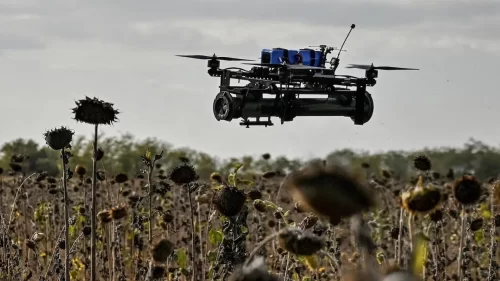
Background on the post-Assad Clash over Manbij in Syria
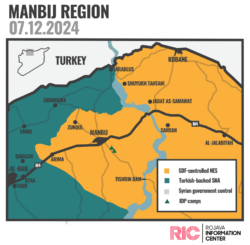 Manbij is a cross-roads city on the western side of the Euphrates not far from the Tishrin Dam hydroelectric plant. It’s the centerpiece of the small-slice of territory west of the river held by the US-backed Kurdish-led Syrian Democratic Forces. It has been for years a focus of struggle between the Turkey-backed Syrian National Army and the SDF (which Ankara considers a terrorist organization due to its informal relation to the Turkey-banned Kurdistan Workers’ Party.)
Manbij is a cross-roads city on the western side of the Euphrates not far from the Tishrin Dam hydroelectric plant. It’s the centerpiece of the small-slice of territory west of the river held by the US-backed Kurdish-led Syrian Democratic Forces. It has been for years a focus of struggle between the Turkey-backed Syrian National Army and the SDF (which Ankara considers a terrorist organization due to its informal relation to the Turkey-banned Kurdistan Workers’ Party.)
Given the collapse of the Assad government and departure of its Russian and Iranian supporters, the Syrian National Army is unrestrained. And the Manbij salient is hard to defend. So Washington reportedly brokered an agreement for the SDF to exit the city and surrounding area. This accommodation will not secure the peace for long. The principal Syrian rebel group – the HTS – will also want to extend Syrian government control over the Kurdish area. Some form of autonomy might be negotiated. But what makes the Kurdish-SDF controlled area especially valuable is oil. Loss of control over this asset contributed to the evisceration of the Assad regime.
Unrelated to the current pressure on the SDF, but important is the fact that the Kurdish group presently oversees ~20 prison camps in Syria holding 10,000 ISIS fighters and upwards of 55,000 related (or possibly related) people. Oil, ISIS, and Erdoğan’s ire define the tension over the SDF’s future. So does the new government’s desire to assert and command national sovereignty.
⇒ Middle East Eye, Syrian opposition forces seize Manbij from Kurdish YPG: Report
⇒ Reuters, Rebels take Syrian city from US-backed group after US-Turkey deal, source says
⇒ Rojava Information Center, Explainer – Turkish and SNA offensive on Manbij (Note: The source is supportive of the Kurdistan Workers Party and partial to the SDF.)
⇒ Politico, There Are 13 Guantanamos in the Syrian Desert
Guardian: Israel, US and Turkey launch strikes in Syria to protect interests
 The warbirds and scavengers are circling: “The US has struck targets associated with Islamic State (IS) in central Syria, while Turkey has attacked US-backed Kurdish forces.” [ Comment: There has been some question about the identity of targets in some strikes. Notably, some local Sunni tribes have been in contention with the Kurdish presence in some areas. These may be tied in to Turkey-supported Sunni militiants, not ISIS. ]
The warbirds and scavengers are circling: “The US has struck targets associated with Islamic State (IS) in central Syria, while Turkey has attacked US-backed Kurdish forces.” [ Comment: There has been some question about the identity of targets in some strikes. Notably, some local Sunni tribes have been in contention with the Kurdish presence in some areas. These may be tied in to Turkey-supported Sunni militiants, not ISIS. ]
“‘Israel also confirmed that it had sent forces into the buffer zone beyond the Israeli-occupied Golan Heights and into former Syrian military positions on Mount Hermon… It said it would continue with airstrikes on former regime sites associated with missiles and chemical weapons, and with airstrikes reported on Monday evening at an air defence installation near the port of Latakia. The Britain-based Syrian Observatory for Human Rights war monitor said on Tuesday that Israel had “destroyed the most important military sites in Syria” with about 250 airstrikes since the fall of the Assad regime. The strikes had targeted airports and warehouses, aircraft squadrons, radars, military signal stations, and multiple weapons and ammunition depots over the past 48 hours, it said.”
“The Turkish president, Recep Tayyip Erdoğan, however insisted that Turkey has no interest in expanding its reach into Syria, despite its backing of the Syrian rebels. ‘Turkey has no eye on the territory of any other country,’ said Erdoğan. ‘The only aim for our cross-border operations is to save our homeland from the terrorist attacks,’ he added, referring to raids targeting the Kurdish-led YPG, based in northeastern Syria.
Guadian, Israel, US and Turkey launch strikes in Syria to protect interests.
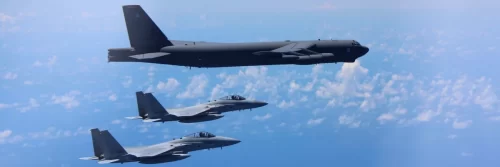
Israeli jets strike 300 targets in Syria, aircraft and naval fleet destroyed
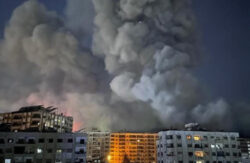 from The Jerusalem Post: “Most of the strikes were in southern Syria and around the city of Damascus, targeting Syrian army bases, with an emphasis on air defense systems and stores of surface-to-surface and surface-to-air missiles.” Sources also report strikes on air bases housing jets and helicopters. “The air force also reportedly struck several strikes on a research center on the outskirts of Damascus and a center for electronic warfare near the Sayeda Zainab area of the capital. Jerusalem Post, Israeli jets strike 300 targets in Syria, aircraft and naval fleet destroyed
from The Jerusalem Post: “Most of the strikes were in southern Syria and around the city of Damascus, targeting Syrian army bases, with an emphasis on air defense systems and stores of surface-to-surface and surface-to-air missiles.” Sources also report strikes on air bases housing jets and helicopters. “The air force also reportedly struck several strikes on a research center on the outskirts of Damascus and a center for electronic warfare near the Sayeda Zainab area of the capital. Jerusalem Post, Israeli jets strike 300 targets in Syria, aircraft and naval fleet destroyed
Public Ukrainian estimate of war dead: 43,000 troops. Other sources disagree
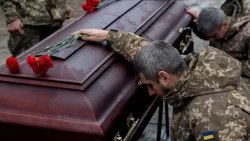 There are several NGO efforts in Ukraine to identify troops killed in war by name, gleaned from public announcements, mostly internet. These offer estimates of between 58,000 and 65,000 dead. A similar effort by dissident Russians working with the BBC has found the names of 82,000 Russian soldiers killed in war. BBC, 43,000 troops killed in war with Russia, Zelensky says.
There are several NGO efforts in Ukraine to identify troops killed in war by name, gleaned from public announcements, mostly internet. These offer estimates of between 58,000 and 65,000 dead. A similar effort by dissident Russians working with the BBC has found the names of 82,000 Russian soldiers killed in war. BBC, 43,000 troops killed in war with Russia, Zelensky says.
The other sources are: Ukrainian losses – WarTears Ukrainian losses – UA Losses Russian losses – Mediazona
North Korea, Russia Defense Treaty Comes into Force
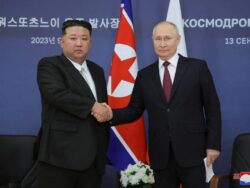 The Defense Post reports the activation of the Kim-Putin defense pack. A serious setback for counter-proliferation efforts – a collateral effect of war. The treaty “obligates both states to provide military assistance ‘without delay’ in the case of an attack on the other, and to jointly oppose Western sanctions.”
The Defense Post reports the activation of the Kim-Putin defense pack. A serious setback for counter-proliferation efforts – a collateral effect of war. The treaty “obligates both states to provide military assistance ‘without delay’ in the case of an attack on the other, and to jointly oppose Western sanctions.”
Blinken Says Ukraine Needs to Get Younger People Fighting Russia
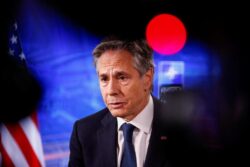 from USNews article: “Blinken’s comments, in an interview with Reuters, reflect a growing view among Western officials that Kyiv urgently needs more manpower as well as money and munitions to reverse Russian battlefield gains. The call-up is currently from the age of 25.” Yes, but take note: Ukrainian public opinion on the war is shifting – currently war-vs-negotiation opinion is split 50/50. And lowering the draft age is bound to grow opinion for settlement.
from USNews article: “Blinken’s comments, in an interview with Reuters, reflect a growing view among Western officials that Kyiv urgently needs more manpower as well as money and munitions to reverse Russian battlefield gains. The call-up is currently from the age of 25.” Yes, but take note: Ukrainian public opinion on the war is shifting – currently war-vs-negotiation opinion is split 50/50. And lowering the draft age is bound to grow opinion for settlement.
Also see: AP, White House pressing Ukraine to draft 18-year-olds so it has enough troops to battle Russia. But Zelenskyy says no, no, no: Ukrainska Pravda, US puts pressure on Zelenskyy to mobilise people under 25, but he is not giving in – advisor.

Warzone: “Claims Swirl Around US Strikes In Eastern Syria”
 US forces may well have attacked (or counter-attacked) Syrian government or Iranian militia units while supporting operations by America’s Syrian Kurdish allies. The possible US attack on Syrian government and/or allied units may well have been inadvertent. But the events go to show that involvement in a chaotic situation leads to chaotic outcomes.
US forces may well have attacked (or counter-attacked) Syrian government or Iranian militia units while supporting operations by America’s Syrian Kurdish allies. The possible US attack on Syrian government and/or allied units may well have been inadvertent. But the events go to show that involvement in a chaotic situation leads to chaotic outcomes.
from the Warzone article:
“On Monday, the Pentagon’s top spokesman was asked if the SDF was preparing ‘to launch an operation in seven villages controlled by al-Assad regime near Conoco oil field.’”
Air Force Maj. Gen. Patrick Ryder responded: “So as I’m sure you can appreciate, we are in contact with the SDF as they are one of our key partners on the enduring defeat of ISIS mission. I won’t speak for the SDF or talk about their potential future operations other than to say that again, we will continue to coordinate closely when it comes to the threat of ISIS and ensuring that they’re not able to resurge throughout Syria or into Iraq. I’ll just leave it there.”
“Ryder, emphasizing that the U.S. has no involvement in the rebel offensive, added that American forces have recently come under fire in the Deir Ezzor area and responded with defensive actions.”
“The U.S. carried out defensive strikes in eastern Syria after MSS Euphrates was attacked, Ryder told reporters… He was quick to point out that they had nothing to do with the rebel offensive or against regime forces.”
“‘This morning, U.S. Central Command forces successfully destroyed several weapons systems in the vicinity of Military Support Site Euphrates in Syria, that included three truck-mounted multiple rocket launchers, a T-64 tank and mortars that presented a clear and imminent threat to U.S. and coalition forces,’ Ryder explained. ‘The self-defense strike occurred after the mobile multiple rocket launchers fired rockets that landed in the vicinity of MSS Euphrates and mortars were fired towards U.S. forces.’
“The US is ‘still assessing who is operating these weapons,’ Ryder continued. ‘But you do know that there are Iranian-backed militia groups in the area that have conducted attacks on MSS Euphrates in the past. There are also Syrian military forces that operate in the area. To be clear, these self-defense actions successfully eliminated imminent threats to U.S. personnel and were not linked to any broader activities in northwest Syria by other groups.’” Warzone, Claims Swirl Around U.S. Strikes In Eastern Syria
Yes, Ukrainian Special Forces have been active in Syria
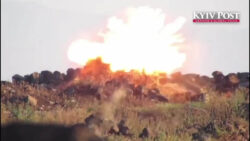 Earlier this year, at least. Kyiv Post, Ukrainian Special Forces and Syrian Rebels Decimate Russian Mercenaries in Syria. It may seem puzzling due to troop shortages along the front line in Ukraine, but the logic is similar to that framing UA’s Kursk incursion: The Syria operation could contribute to a significant distraction for Russian forces should the Syrian conflict re-ignite – which is has. More than that, action in Syria (and the Sahel) lends some credence to Kyiv’s insistence that it is fighting a global war for the West against Russia. In this story, cooperation with an Al Qaeda spinoff -Hayat Tahrir al-Sham (HTS) – a US-designated terrorist organization, is discounted. Also see:
Earlier this year, at least. Kyiv Post, Ukrainian Special Forces and Syrian Rebels Decimate Russian Mercenaries in Syria. It may seem puzzling due to troop shortages along the front line in Ukraine, but the logic is similar to that framing UA’s Kursk incursion: The Syria operation could contribute to a significant distraction for Russian forces should the Syrian conflict re-ignite – which is has. More than that, action in Syria (and the Sahel) lends some credence to Kyiv’s insistence that it is fighting a global war for the West against Russia. In this story, cooperation with an Al Qaeda spinoff -Hayat Tahrir al-Sham (HTS) – a US-designated terrorist organization, is discounted. Also see:
Ukrainska Pravda, Ukraine plans attacks on Russian forces in Syria – The Washington Post
The Hill, Ukraine is taking the fight to Russia in Africa, Syria
US Deployment Areas in Syria
The map below, produced by Jusoor (a research group in Turkey), purports to show a full picture of US military deployment sites as of summer 2024. We cannot confirm its accuracy.
![]()
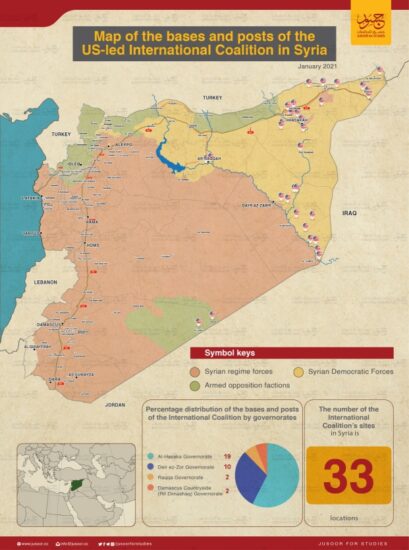
![]()
Who controls Syria
Note: The first map does not accurately portray the deployment of US troops. Only a small minority reside in the area marked “US Outpost.” Most are in multiple locations throughout the Kurdish held areas.
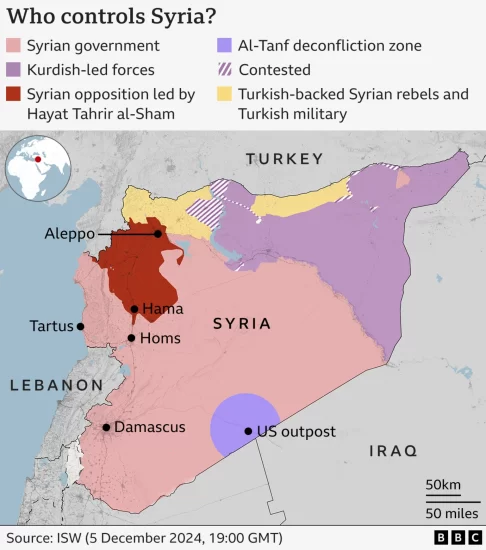
How Syria’s rebels became makers of drones and guided missiles
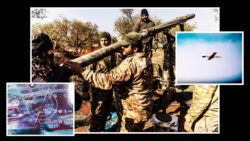 “Sourcing basic weaponry has been relatively easy for HTS: Syria has been awash with arms since 2011, when Turkey and Arab nations, with US support, flooded the country with weapons to help bolster the rebels in the civil war against the Iran-supported regime. But HTS’s homegrown manufacturing, particularly of drones and missiles, has enabled it to pose new threats to a regime that lacks significant anti-drone capabilities.” See article from Financial Times HERE.
“Sourcing basic weaponry has been relatively easy for HTS: Syria has been awash with arms since 2011, when Turkey and Arab nations, with US support, flooded the country with weapons to help bolster the rebels in the civil war against the Iran-supported regime. But HTS’s homegrown manufacturing, particularly of drones and missiles, has enabled it to pose new threats to a regime that lacks significant anti-drone capabilities.” See article from Financial Times HERE.
Also see: Middle East Eye, Shaheen drones: The new rebel weapon in Syria’s skies
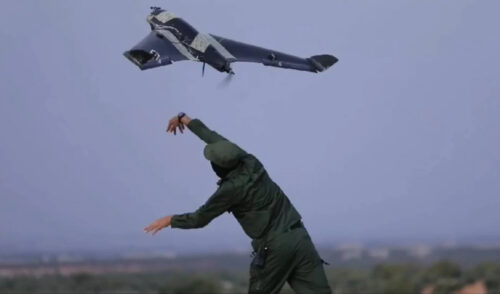
The Patient Efforts Behind Hayat Tahrir al-Sham’s Success in Aleppo
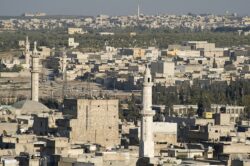 from War on the Rocks: Article explores in useful detail the recent evolution of Hayat Tahrir al-Sham, its organization, strategy, and planning that enabled its success in Aleppo.
from War on the Rocks: Article explores in useful detail the recent evolution of Hayat Tahrir al-Sham, its organization, strategy, and planning that enabled its success in Aleppo.
What is Hayat Tahrir al-Sham? And how did the Islamist group evolve into a key player in Syria’s civil war?
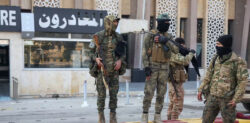 from The Conversation: “The group originated as an offshoot of the Nusra Front, the official al-Qaida affiliate in Syria. In a pivotal shift in 2016… the Nusra Front publicly cut ties with al-Qaida and adopted the new name Jabhat Fateh al-Sham, which means ‘Front for the Conquest of the Levant.’ The following year, it merged with several other factions in the Syrian war to become Hayat Tahrir al-Sham, or the ‘Organization for the Liberation of the Levant.’ … This rebranding aimed to move away from al-Qaida’s global jihadist agenda… It allowed Hayat Tahrir al-Sham to focus on issues specific to Syrians… In other words, it needed to balance its radical Islamist origins with the demands of local governance and political engagement.”
from The Conversation: “The group originated as an offshoot of the Nusra Front, the official al-Qaida affiliate in Syria. In a pivotal shift in 2016… the Nusra Front publicly cut ties with al-Qaida and adopted the new name Jabhat Fateh al-Sham, which means ‘Front for the Conquest of the Levant.’ The following year, it merged with several other factions in the Syrian war to become Hayat Tahrir al-Sham, or the ‘Organization for the Liberation of the Levant.’ … This rebranding aimed to move away from al-Qaida’s global jihadist agenda… It allowed Hayat Tahrir al-Sham to focus on issues specific to Syrians… In other words, it needed to balance its radical Islamist origins with the demands of local governance and political engagement.”
Syria’s North-western Front Erupts
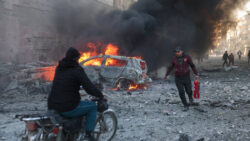 In-depth report from The International Crisis Group is HERE. “Syria’s civil war, which has been largely frozen for over four years, has erupted again in startling fashion… The offensive has overturned a delicate set of arrangements that had kept fighting in the north west fairly quiet since 2020, when Russia and Türkiye struck a ceasefire deal that froze the front lines.”
In-depth report from The International Crisis Group is HERE. “Syria’s civil war, which has been largely frozen for over four years, has erupted again in startling fashion… The offensive has overturned a delicate set of arrangements that had kept fighting in the north west fairly quiet since 2020, when Russia and Türkiye struck a ceasefire deal that froze the front lines.”
Syrian Rebels’ Surprise Offensive Highlights Assad Regime’s Weakness
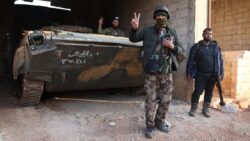 From CSIS: “The Kremlin has been pushing for normalization between Ankara and Damascus and has been frustrated by Assad’s intransigence. In the face of Assad’s refusal to reconcile, Turkey may have allowed for a rebel offensive for the first time in years to encourage the regime to reconsider… [The] lightning-fast offensive is a monumental shift in the Syrian conflict and highlights the regime’s inherent weakness. Only after years of siege and heavy bombardment, with the help of Iran and Russia, was the regime able to capture all of Aleppo city in 2016. Within a day, rebels were able to take the city with little resistance.” See CSIS article: HERE – Upshot: The Assad government is weak while Russian and Iran-linked supporting groups are otherwise engaged. The Al Qaeda spin-off group Hayat Tahrir Al-Sham (HTS) in northwest Syria has spent four years of ceasefire building strength for this opportunity.
From CSIS: “The Kremlin has been pushing for normalization between Ankara and Damascus and has been frustrated by Assad’s intransigence. In the face of Assad’s refusal to reconcile, Turkey may have allowed for a rebel offensive for the first time in years to encourage the regime to reconsider… [The] lightning-fast offensive is a monumental shift in the Syrian conflict and highlights the regime’s inherent weakness. Only after years of siege and heavy bombardment, with the help of Iran and Russia, was the regime able to capture all of Aleppo city in 2016. Within a day, rebels were able to take the city with little resistance.” See CSIS article: HERE – Upshot: The Assad government is weak while Russian and Iran-linked supporting groups are otherwise engaged. The Al Qaeda spin-off group Hayat Tahrir Al-Sham (HTS) in northwest Syria has spent four years of ceasefire building strength for this opportunity.
What does Türkiye gain from the rebel offensive in Syria?
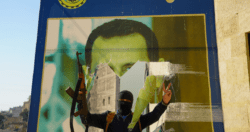 Three goals: 1. A political solution that empowers Sunni Islamist rebels. 2. A political solution that draws Syrian refugees out of Türkiye and back into Syria. 3. A new arrangement that undermines the position and role of Kurdish forces in Syria.
Three goals: 1. A political solution that empowers Sunni Islamist rebels. 2. A political solution that draws Syrian refugees out of Türkiye and back into Syria. 3. A new arrangement that undermines the position and role of Kurdish forces in Syria.
Atlantic Council, What does Turkey gain from the rebel offensive in Syria?
What is Hayat Tahrir Al-Sham (HTS)?
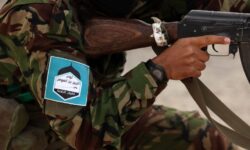 “The former al Qaeda affiliate now governs approximately two million people, half of whom are internally displaced Syrians. Over the past three years, HTS consolidated power within its territory and sought to convince the international community that it no longer merits its pariah status as a terrorist organization.” CSIS, Examining Extremism: Hayat Tahrir Al-Sham (HTS)
“The former al Qaeda affiliate now governs approximately two million people, half of whom are internally displaced Syrians. Over the past three years, HTS consolidated power within its territory and sought to convince the international community that it no longer merits its pariah status as a terrorist organization.” CSIS, Examining Extremism: Hayat Tahrir Al-Sham (HTS)

